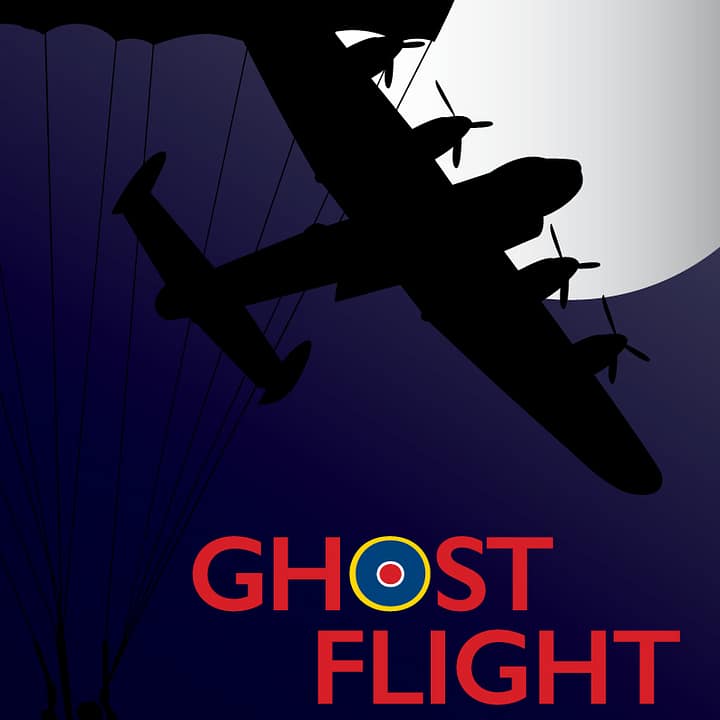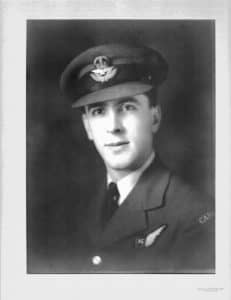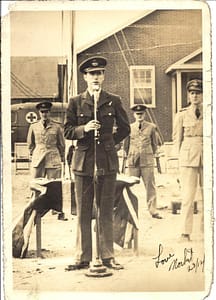
The Story of Charlie’s War 
Charlie’s older brother Norbert David Roche
My brother went through the whole war and returned and that’s why I joined. He’s the influence, that’s why I joined the Air Force.
He was with the Bank of Montreal but he spent all his money taking flying lessons and earned his pilot’s licence. When war broke out, they said, well everybody wants to be a pilot. So instead of pilot Norbert ended up as a Wireless Air Gunner. He said, well I’ll take Wireless Air Gunner then, but he was a pilot officially. That’s the way it goes.
Norbert was on Wellingtons, they had only two engines. We used the Wellington for training. But the Lancaster was a four-engine. But he was with the Royal Air Force and that was the plane they used.
We didn’t have our own Canadian Air Force at the beginning – the Battle of Britain time, (July 10, 1940-Oct. 31, 1940). He was one of the earlier people that went over.

He had some terrific experiences, like being shot down over the North Sea. Some fishermen picked them up with fishnets. They survived that way. He was back flying, a week later he was back on doing bombing.
My brother came home in 1942 because he did his operations in 1940 and 1941. He toured Canada for the war effort, encouraging others to join. Then he went overseas again.
Norbert would stay at the Rothschild estate in Paris when he’d go there. The Royal Air Force was using it. He had finished his tour of operations and survived it.
He was stationed at Biggin Hill aerodrome, an RAF base in south-east London in Jan. 1945. At Biggin Hill he was on a mail delivery service and they travelled all over the world. He went to Morocco and Gibraltor and they’d deliver mail to wherever the troops were. That was quite a job for him. He loved the Air Force; he wanted to stay in the force. Mine was just a temporary thing – I wasn’t even excited about flying. It was like sitting on a bus or something except you’re up in the air.

home when Mr. Roche read this news article. Mr.
Roche jumped up from his chair to show everybody the article. They hadn’t heard about it from Norbert.

Pilot Officer
Norbert had gone to his father as soon as the news came out that Hitler had invaded Poland. He wanted to tell his father that he was joining the Royal Air Force. He knew a lot of Polish Canadians and was incensed that Hitler had marched into Poland. Hitler had gone into Poland on Sept. 1st, 1939, on Sept. 3rd, 1939 Britain declared war on Germany.
In 1939 Norbert was working for the Bank of Montreal. He had taken flying lessons and earned his pilot’s licence, which was why he chose to join the Royal Air Force.
In 1945, just after the war ended, Norbert was at home before he went for his second to last flight to bring supplies for a humanitarian mission in Europe. His family drove him to the airport and he told them that after this mission he had one more flight to do, then he would be back home for good. On this flight, Norbert was back in Germany to fly medicine to Poland.
The plane crashed in the mountains in Germany and there were no survivors.
The following image is from the article “Mission to Warsaw” by Hugh Halliday about the tragic flight to Poland. The article is in the “Observair, Ottawa Chapter Newsletter, Canadian Aviation Historical Society, Volume 49, Number 4, April 2012”. The article was given to me by Mr. Keith Walker, a member of the Canadian Aviation Historical Society. Keith took a photo of the memorial plaque for me.





The article can also be read at: https://legionmagazine.com/en/2011/12/penicillin-for-poland-a-tale-of-two-plaques-air-forcepart-48/


Memorial Cross 
back of the Memorial Cross
“The Memorial Cross is an award that has been granted since 1919 to the loved ones of Canadian armed forces personnel who died in service or whose death was attributed to their service. It is granted by the Government of Canada and is frequently referred to as the Silver Cross. In the past it has only been given to mothers and widows.
The Memorial Cross, the gift of Canada, was issued as a memento of personal loss and sacrifice on the part of widows and mothers of Canadian sailors, soldiers and airmen who died for their country during the war. In the centre, within a wreath of laurel, is the royal cypher of the reigning monarch GVIR for King George the Sixth. The reverse of the Cross is engraved with the name and service number of the individual commemorated.”
Quote from: http://www.veterans.gc.ca/eng/remembrance/medals-decorations/memorial-cross